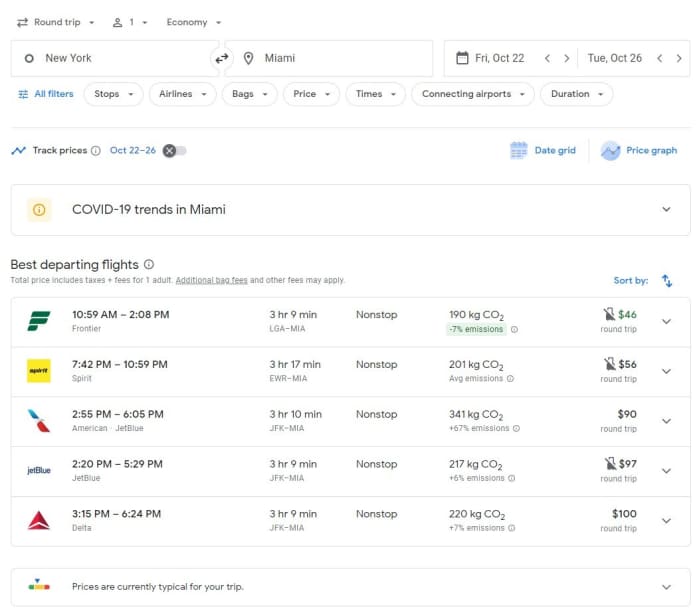This post was originally published on this site
A new feature from Google might help some jetsetters feel a little bit less guilt about their travel decisions.
Google Flights
GOOGL,
rolled out a new function Wednesday that allows travelers to find out the carbon emission estimates for different flight options. The information appears within flight search results and on booking pages, and people can even sort their results by the carbon emissions associated with each flight.
The feature relies on emission estimates from the European Environmental Agency. In its help center, Google
GOOG,
described the new tool as being designed “to help you make more sustainable travel choices.” (Google did not return a request for comment.)
Travel experts suggested the feature could have a large captive audience. “Members tell us all the time that while they love traveling, the environmental impact of air travel in particular is enough to give them pause,” said Willis Orlando, member operations specialist at Scott’s Cheap Flights, a platform that provides subscribers with travel deals. “While it’s certainly not our members’ primary concern, it is very clear that there is a passionate subset of avid travelers who are becoming increasingly concerned with what impact their next trip may have on the environment.”
How travelers use the information they might glean from Google Flights’ new tool could determine how useful it is for conservation purposes.
Air travel’s carbon footprint varies widely
As it turns out, a small choice like flying in a premium seat or with one airline over another can actually make a significant difference in terms of environmental impact, according to travel and conservation experts.
“Travelers will learn how much difference a choice of airline, seat class, routing and destination can make on the carbon footprint of their business or holiday travel,” said Daniel Scott, a professor at the University of Waterloo in Canada whose research focuses on climate change and tourism.
The least harmful itinerary can release as much as 63% less carbon dioxide as the most-polluting flight, according to a report released in July by the International Council on Clean Transportation. That difference can depend on a number of factors.
A more densely-filled flight might have a smaller footprint than one where a lot of the space on the plane is occupied by sparsely-filled first and business classes. Older planes emit more greenhouse gases than newer aircraft. Even the precise route the plane flies can play a role.

A screenshot of a Google Flights search displays the carbon emissions associated with the different travel options.
The way Google shares this information isn’t necessarily straightforward at first glance though. “The raw numbers supplied by Google will tell the average consumer very little about what impact their flight will have,” Orlando said. “You can just imagine most folks’ eyes starting to glaze over.”
Researching flights between New York and Miami, one option from American Airlines
AAL,
would result in 341 kilograms of carbon dioxide being emitted, whereas another option from Delta
DAL,
only carried a footprint of 220 kilograms of carbon dioxide. The price difference was only $10, and even better options in terms of the environmental impact were available from low-cost carriers such as Frontier
ULCC,
Spirit and JetBlue
JBLU,
The strategy of shopping based on emissions isn’t foolproof though. “Airlines often swap out planes without notice, so you might not always get the same amount of carbon emissions you thought you were signing up for,” said Caroline Teel, managing editor at SmarterTravel.
Also see: JetBlue accelerates its purchases of sustainable jet fuel at New York airports
Airlines are accused of greenwashing
Young environmental activist Greta Thunberg has advocated for carbon-offset programs, which allow travelers to tack on an extra fee when they buy a plane ticket. That money usually then goes to climate-friendly initiatives such as planting trees or installing solar panels.
Beyond encouraging people to purchase tickets for flights that have smaller footprints, the new Google Flights tool could expand the popularity of these offset programs, Teel argued.
But these programs and other seemingly environmentally-friendly efforts by the aviation sector have come under scrutiny. Actual green tourism is a very small subset of the overall industry, said Edward H. Hujbens, a professor at Wageningen University in the Netherlands, but many companies want to associate themselves with eco-tourism because it can improve their image.
Read more: As Bezos completes Blue Origin mission, many ask what’s the climate-change impact?
“The reality is that most of the efforts are plasters on a hemorrhaging wound, akin to hanging up your towel to save water for washing in the hotel,” Huijbens said.
A recent report published in the academic journal Tourism Management found that the claims airlines made about their carbon offset offerings were sometimes misleading, and were used as tools to engage in “green” marketing and improve their corporate image. In particular, more than half of the airlines studied described their carbon-offsetting product or program as being carbon neutral, when in reality these products don’t neutralize emissions but instead are meant to mitigate them, the researchers wrote.
The new Google Flights tool, though, might actually improve accountability, Scott argued.
“There is a lot of greenwashing in the aviation sector and that is why third-party information sources like Google are important to provide transparent and data-driven information to consumers to empower them to make climate responsible decisions without the spin,” he said.

